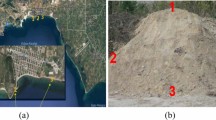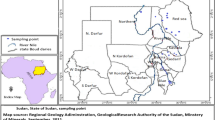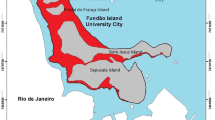Abstract
Phosphogypsum is a by-product from the phosphate fertilizer industry, disposed in huge stacks in open-air storage areas. Its use in agriculture may be a solution to decrease these stacks, because, among its other uses, phosphogypsum can be used as a soil amendment to provide calcium and sulphur for major crops. However, it contains rare earth elements (REE) from its raw material. The objective of this study was to determine the concentrations of REE in phosphogypsum stacks Imbituba (southern Brazil) in order to verify the possibility of contamination in the surrounding of the stacks due to the disposal and to ensure the safe use of phosphogypsum in agriculture. Samples of phosphogypsum were collected and REE were determined by neutron activation analysis and gamma spectrometry. There was no leaching of the REE through the profile of the stacks, which suggests that the occurrence of REE in the phosphogypsum is associated with the formation of sulphates, carbonates, fluorides and phosphates. The results indicate that application of phosphogypsum from Imbituba to agricultural soils can contribute to increase the concentration of rare earth elements in the cultivated soils, but these are not available to plant uptake.









Similar content being viewed by others
References
ABNT (1987) NBR 10006: Solubilização de resíduos. Associação Brasileira de Normas Técnicas, Rio de Janeiro
Bellido AVB (1988) Neutron activation analysis of ancient Egyptian pottery. Ph. D. Thesis. University of Manchester, Manchester
Bode P, Hoffman EL, Lindstrom RL, Parry SJ, Rosenberg RJ (1990). Practical Aspects of Operating a Neutron Activation Analysis Laboratory. In: Tecdoc 564. IAEA, Vienna, p 251
Borges RC (2011) Caracterização Química e Radiológica do Fosfogesso de Imbituba-SC e Aspectos Ambientais do Uso na Recuperação de Solos Agrícolas. Ph. D. Thesis. Universidade Federal Fluminense, Niterói
Bragança MJCS, Tauhata L, Clain AF, Moreira I (2003) Minerais fosfatados para serem utilizados como materiais de referência radioativos. In: Metrologia-2003.Sociedade Brasileira de Metrologia (SBM), Recife
Chua H (1998) Bio-accumulation of environmental residues of rare earth elements in aquatic flora Eichhornia crassipes (Mart.) Solms in Guangdong Province of China. Sci Total Environ 214:79–85
Departamento Nacional de Produção Mineral (DNPM) (1993) Sumário Mineral 1992. Ministério das Minas e Energia, Brasília
Einax JW, Soldt U (1999) Geostatistical and multivariate statistical methods for the assessment of polluted soils—merits and limitations. Chemometr Intell Lab 46:79–91
El-Taher A (2010) Rare earth elements content in geological samples from eastern desert, Egypt, determined by instrumental neutron activation analysis. Appl Radiat Isot 68:1859–1863
Embso P, McLaughlin PI, Breit GN, Bray EA, Koening AE (2015) Rare earth elements in sedimentary phosphate deposits: solution to the global REE crisis? Gondwana Res 27:776–785
Environmental Systems Research Institute—ESRI. 2011. Desktop Help 10.0—How IDW works. http://help.arcgis.com/en/arcgisdesktop/10.0/help/index.html#/How_IDW_works/009z00000075000000/. (Accessed on 05 Nov 2012)
Fernandes HM, Rio APM, Franklin MR (2004) Impactos Radiológicos da Indústria do Fosfato. CETEM, Rio de Janeiro
Fortescue JAC (1992) Landscape geochemistry: retrospect and prospect - 1990. Appl Geochem 7:1–53
Gorbunov AV, Frontasyeva MV, Gundorina SF, Onischenko TL, Maksiuta BB, Pal CS (1992) Effect of agricultural use of phosphogypsum on trace elements in soils and vegetation. Sci Total Environ 122:337–346
Hu Z, Haneklaus S, Sparovek G, Schnug E (2006) Rare earth elements in soils. Commun Soil Sci Plan 37(9):1381–1420
Ihlen PM, Schiellerup H, Gautneb H, Skar O (2014) Characterization of apatite resources in Norway and their REE potential—a review. Ore Geol Rev 58:126–147
Kabata-Pendias A, Mukherjee AB (2007) Trace elements from soil to human. Springer, New York
Kabata-Pendias A, Pendias H (1992) Trace elements in soils and plants, 2nd edn. CRC Press, Boca Raton
Koeberl O, Bayer PM (1992) Concentrations of rare earth elements in human brain tissue and kidney stones determined by neutron activation analysis. J Alloys Compd 180:63–70
Lapido-Loureiro FE (2008) Fertilizantes e sustentabilidade: o fósforo na agricultura brasileira. CETEM, Rio de Janeiro
Le Bourlegat FM (2010) Disponibilidade de Metais em Amostras de Fosfogesso e Fertilizantes Fosfatados Utilizados na Agricultura. Instituto de Pesquisas Energéticas e Nucleares, São Paulo
Lebedev VN, Lokshin EHP (1999) Method of isolation of rare-earth elements from phosphogypsum Patent Number(s): RU2158317-C1 Assignee: as Russia kola rare elements and minerals
Lima RMF (1989) Novos coletores na flotação do minério fosfático de Tapira, Minas Gerais. Dissertação (Mestrado)—Universidade Federal de Minas Gerais, Minas Gerais
Lokshin EHP, Vershkova YUA, Kalinnikov VT (2002) Recovering rare-earth minerals from phosphogypsum Patent Number(s): RU2225892-C1 Assignee: as Russia kola rare elements & minerals
Lokshin EHP, Kalinnikov VT, Ivlev KG (2005) Method of recovering rare-earth elements from phosphogypsum Patent Number(s): RU2293781-C1 Assignee: as Russia kola rare elements & minerals
Melamed R, Neto JF (2008) Fertilizantes: Agroindústria e Sustentabilidade. CETEM, Rio de Janeiro
Mendonça, F, Danni-Oliveira IM (2007) Climatologia: noções básicas e climas do Brasil. São Paulo
Menzel RG (1968) Uranium, radium and thorium content in phosphate rocks and their possible radiation hazard. J Agr Food Chem 16:231–235
Mitsui Fertilizer Company (2006) http://www.yoorin.com.br/Folhetos/Folheto_Yoorin.pdf. Accessed 15 Aug 2013
Oliveira KAP (2012) Fator de Transferência de Elementos Terras Raras em Solos Tropicais Tratados com Fosfogesso. Universidade Federal de Minas Gerais, Belo Horizonte
Picard S (2002) Rare earth element contents of jurassic fish and reptile teeth and their potential relation to seawater composition. Chem Geol 186:1–16
Rutherford PM, Dudas MJ, Samek RA (1994) Environmental impacts of phosphogypsum. Sci Total Environ 149:1–38
Sabbioni E, Pietra R, Gaglione P, Vocaturo G, Colombo F, Zanoni M, Rodi F (1982) Long-term occupational risk of rare earth pneumoconiosis. Sci Total Environ 25:310–316
Sabiha-Javied, Waheed S, Siddique N, Tufail M, Chaudhry MM, Irfan N (2008) Elemental analysis of phosphate rocks: for sustainable agriculture in Pakistan. J Radionalytical Nucl Chem 278(1):17–24
Santos AJG, Mazzilli BP, Fávaro DIT, Silva PSC (2006) Partitioning of radionuclides and trace elements in phosphogypsum and its source materials based on sequential extraction methods. J Environ Radioact 87:52–61
Saueia CH, Mazzilli BP, Fávaro DIT (2005) Natural radioactivity in phosphate rock, phosphogypsum and phosphate fertilizers in Brazil. J Radioanal Nucl Chem 264(2):445–448
Sneller FEC, Kalf DF, Weltje L, Wezel Van AP (2000) Maximum permissible concentrations and negligible concentrations for rare earth elements (REEs). IVM National Institute for Public Health and the Environment, Report 601501011. Netherlands
Souza DMG, Rein TA, Lobato E, Ritchey KD (1992) Sugestões para diagnose e recomendação de gesso em solos de cerrado. In: II Seminário sobre o uso de gesso na agricultura. Instituto Brasileiro do Fosfato, Uberaba
Sun SS, McDonough WF (1989) Chemical and isotopic systematics of oceanic basalts: implications for mantle composition and processes. Geol Soc Lon 42(2):313–345
Turra C, Fernandes EAN, Bacchi MA (2011) Evaluation on rare earth elements of Brazilian agricultural supplies. J Environ Chem Ecotox 3(4):86–92
Tyler G (2004) Rare earth elements in soil and plant system—a review. Plant Soil 267:191–206
Uchida S, Tagami K, Hirai I (2007) Soil-to-plant transfer factors of stable elements and naturally occurring radionuclides (1) Upland field crops collected in Japan. J Nucl Sci Tech 44(4):628–640. doi:10.1080/18811248.2007.9711851
Valkov AV, Valkov DA (1996) Procedure for extraction of rare earth elements from phosphogypsum includes dissolving phosphogypsum in water or mineral acid or inorganic salt solution Patent Number(s): RU2104938-C1 Assignee: MITSAR CO LTD
Varella CAA, Junior DG de S (2008). Estudo do Interpolador IDW do Arcview para Utilização em Agricultura de Precisão [Study of IDW Interpolator of Arcview for Use in Precision Agriculture]. http://www.ufrrj.br/institutos/it/deng/varella/Downloads/IT190_principios_em_agricultura_de_precisao/Aulas/Estudo%20do%20interpolador%20idw%20arcview.htm. (Accessed on 11 Nov 2012)
Acknowledgments
The authors would like to acknowledge the Conselho Nacional de Desenvolvimento Científico e Tecnológico (CNPq) and Coordenação de Aperfeiçoamento de Pessoal de Nível Superior (CAPES) for the scholarship and financial support. Authors are grateful to Mr. Ferreira for authorizing the sampling.
Author information
Authors and Affiliations
Corresponding author
Rights and permissions
About this article
Cite this article
Borges, R.C., Fávaro, D.I.T., Caldas, V.G. et al. Instrumental neutron activation analysis, gamma spectrometry and geographic information system techniques in the determination and mapping of rare earth element in phosphogypsum stacks. Environ Earth Sci 75, 705 (2016). https://doi.org/10.1007/s12665-016-5468-x
Received:
Accepted:
Published:
DOI: https://doi.org/10.1007/s12665-016-5468-x




